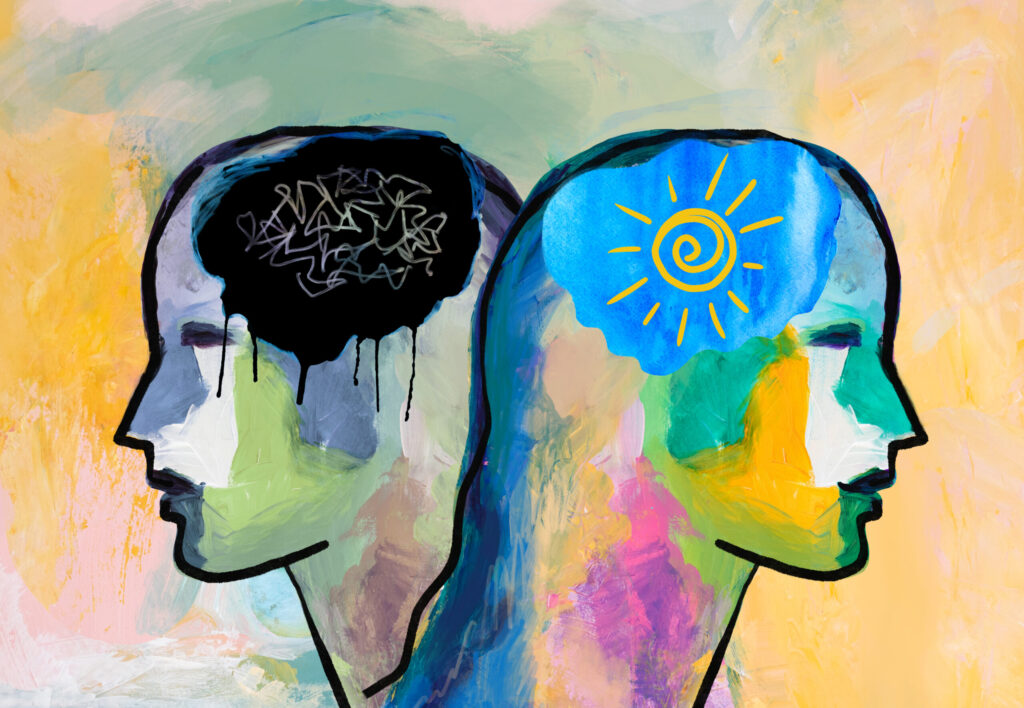Both LGBTQ+ youth and adolescent people of color experienced higher rates of mental health issues than their peers, like feeling sad every day for more than two weeks, according to a new data analysis by KIDS COUNT. (Stock illustration by stellalevi via Getty Images)
This story discusses suicide. If you or someone you know is contemplating suicide, please call or text the National Suicide and Crisis Lifeline at 988.
Over four years since the pandemic disrupted the lives and developmental milestones of young Rhode Islanders, many adolescents and teens continue to struggle with mental health concerns — especially young people of color and LGBTQ youth, a new report by Rhode Island KIDS COUNT suggests.
The policy brief and data presentation, released Monday, paired interviews and statistics to examine disparities in youth who are experiencing mental health challenges. Focus group interviews were conducted with kids from local youth support nonprofits Young Voices and Youth Pride Inc. Quantitative data came from the Rhode Island Youth Risk Behavior Survey, which is conducted biannually by the Rhode Island Department of Health.
“This publication shows just how critical it is to disaggregate data and incorporate community voice into recommendations,” Stephanie Geller, deputy director of Rhode Island KIDS COUNT, said in a statement. “This gets to the heart of equity — understanding that what is measured can then be effectively addressed. Communities experiencing a particular issue are the experts on that topic.”
For example, from 2015 to 2023, feelings of sadness or hopelessness have been pretty consistently observed among Rhode Island’s teenagers at slightly lower numbers than the national rate, according to data from the U.S. Centers for Disease Control and Prevention’s Youth Risk Behavior Survey. In 2023, 36% of Rhode Island high schoolers reported feeling down, compared to 40% of high schoolers nationally.
But the numbers can be higher when read along lines of gender, sexual orientation, race or ethnicity. In 2023, 60% of Rhode Island youth who identified as lesbian, gay or bisexual reported feeling sad or hopeless for more than two weeks. For kids who considered themselves questioning, that number was 71%. Only 26% of youth identifying as heterosexual reported persistent sadness and hopelessness in last year’s data.
White high school students reported sadness and hopelessness at 31% in 2023. But 37% of their Black peers, and 41% of Hispanic students, reported having these feelings consistently in 2023. Pandemic-era spikes in rates of youth sadness affected all groups, but in Rhode Island, Black youth saw the largest increase, from 28% in 2019 to 40% in 2021.
Although Rhode Island has been a national leader in passing protections for LGBTQ+ people, our kids still suffer. … All should feel welcomed, loved, and have dreams for their future.
– Paige Parks, executive director of Rhode Island KIDS Count
“It is the responsibility and duty of every adult to protect the mental health of our kids — especially our BIPOC (Black, Indigenous and other people of color) and LGBTQ+ youth who are trying their best to navigate a complex and divisive world,” said Paige Parks, the executive director of Rhode Island KIDS COUNT in a statement.
“Although Rhode Island has been a national leader in passing protections for LGBTQ+ people, our kids still suffer,” Parks added. “No youth in Rhode Island should be contemplating and attempting suicide. All should feel welcomed, loved, and have dreams for their future.”
In 2023, suicide attempt rates were highest among transgender students (36%), with LGBT, questioning and Hispanic students also above 10%. The suicide attempt rates for white or heterosexual students were 7% and 6%, respectively.
Less stigma seen with help-seeking
Youth in the focus groups mentioned that while there is less stigma associated with mental health, cultural differences can complicate treatment and seeking help, especially when it comes to the mental health workforce and availability of counselors in schools.
“The best kind of schools are trauma-informed schools,” said one student interviewed. “It will help them feel understood … ’cause not all kids are bad kids or ‘troubled kids.’ They’re just going through something right now, and we need adults who are not only trauma-informed but know how to fulfill their emotional needs and can communicate with them on their level.”
“The majority of what we need is people that will believe in us and that will understand where we’re coming from,” another student is quoted in the report.
Discrimination based on students’ identities also played heavily into negative feelings. In 2023, every racial or ethnic category — Asian, Black, Hispanic/Latino and multiple races — said they felt they were treated badly because of their race or ethnicity at rates ranging from 48% (Hispanic/Latino students) to 66% (Asian students). Among white students, 16% reported being treated badly on account of their race.
The focus group students said that they commonly found racism, toxicity and discrimination online.
“It’s a bunch of negativity,” one student in the focus group said.
But not all social media is bad, Geller said.
“While social media can cause a lot of harm when young people see hateful statements directed against them as an individual or against people who share their identity as a young person of color or a part of the LGBTQ+ community, some young people also find social media to be a resource for teens,” Geller said in an Oct. 10 email.
Geller cited a 2021 Advisory on Protecting Youth Mental Health by the U.S. Surgeon General that noted LGBTQ+ youth “may be more vulnerable than other young people to cyberbullying but also more likely to consider social media important for feeling less alone, expressing themselves, finding inspiration, and getting support.”
The KIDS COUNT report includes a page of recommendations, including ensuring students’ privacy when it comes to their gender identity and increasing resources for school mental health professionals.
The report also suggests diversifying workforces so that “youth can have mental health professionals that look like them, speak their language, and understand their identities and experiences.”
GET THE MORNING HEADLINES.

